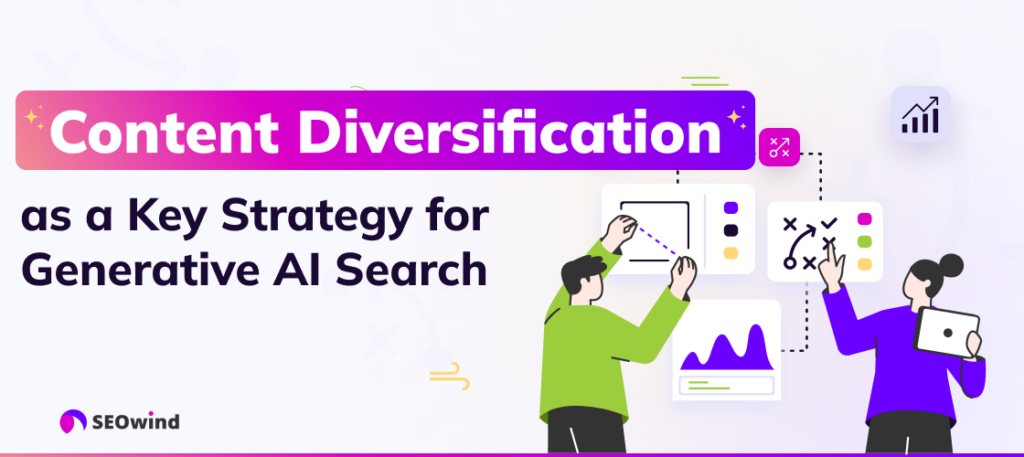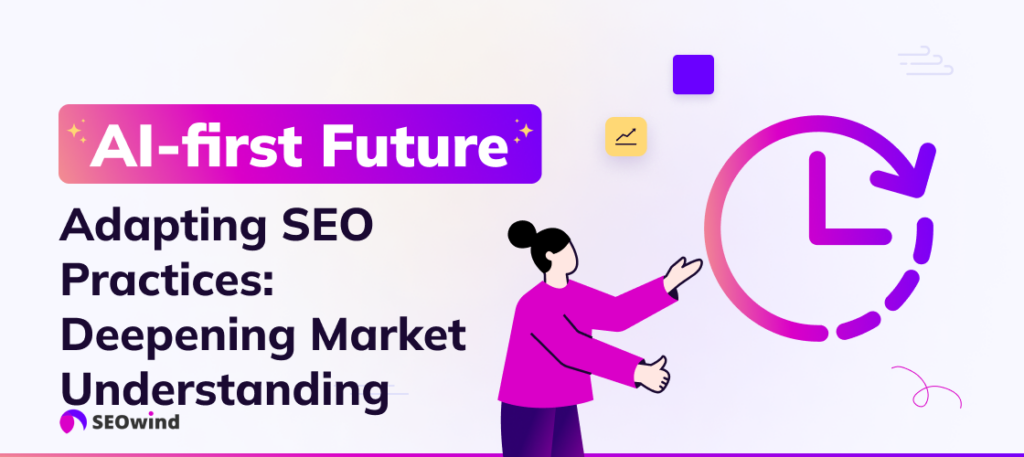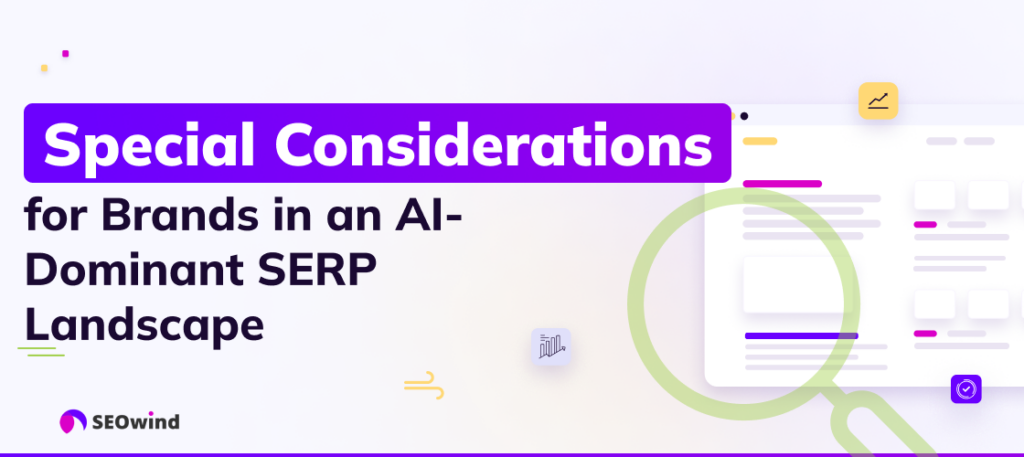Imagine that when you use a search engine, instead of sifting through countless blue links, you’re greeted with concise, AI-powered summaries that answer your search queries instantly. That’s precisely what Search Generative Experience (SGE) does. This shift in how we interact with search engines presents exciting new opportunities for brands and SEOs. In this comprehensive guide, we’ll break down the essentials of SGE and equip you with actionable strategies to thrive in this new era of search.
Introduction to SGE

Before diving into the specifics, let’s first understand how SGE fits into the grand scheme of search engine evolution.
The Evolution of Google’s Search Capabilities
From its humble beginnings as a simple list of links, Google Search has constantly evolved. We’ve witnessed the rise of universal search results, knowledge graphs, and featured snippets, each iteration enhancing the search experience. SGE represents a significant leap forward. It’s not just about delivering information. It’s about understanding and fulfilling user intent like never before.
SGE vs. Traditional SEO: What’s the difference?
Traditional SEO focuses on optimizing websites and content to rank higher on search engine result pages (SERPs) for specific keywords. While keywords remain important, SGE focuses on providing comprehensive, contextually relevant answers. Imagine SGE as the next layer built on the foundation of traditional SEO. Your optimized website and content are still crucial, but now they feed into a system that generates more nuanced and direct responses for users.
It’s Google’s ambitious next step toward a more intuitive and conversational search experience. But how does it actually work?
Key Components and Features of SGE
At its core, Google SGE uses the power of AI and, more specifically, a large language model (LLM) that is very similar to the technology that powers ChatGPT. This LLM has been trained on a vast dataset of text and code, allowing it to understand and generate human-like text. When you input a search query, SGE doesn’t just look for exact keyword matches; it tries to understand the intent behind your words.
Let’s say you’re planning a trip to Italy and search for “best time to visit Rome.” Instead of bombarding you with links to travel agencies, SGE might provide a conversational summary highlighting the optimal months to visit, considering factors like weather, crowds, and local events. This is just one example of how SGE aims to deliver a more personalized and informative search experience.
Google SGE Modules and Their Impact on SERPs
But how does this translate to SERPs? Google SGE introduces new modules and features that significantly impact how information is presented. One of the most noticeable changes is the appearance of AI-powered snapshots at the top of the SERP for certain queries. These snapshots provide users with concise and direct answers to their questions, often eliminating the need to click through to other websites.
Additionally, SGE can change the SERP landscape by prioritizing different types of content. For instance, content that is well-structured, informative, and aligned with search intent is more likely to be favored by SGE algorithms. This means that creators who prioritize quality and user experiences will likely benefit most from this shift in search.
Pay Special Attention to YMYL Keywords in SGE
The impact of SGE is even more pronounced when it comes to “Your Money or Your Life” (YMYL) keywords. These are search terms related to topics that could significantly impact a person’s health, finances, safety, or well-being. Think of queries like “best heart rate medication” or “how to invest in stocks.”
Given the sensitive nature of these topics, Google’s SGE is designed to prioritize trustworthiness and accuracy above all else. For YMYL keywords, SGE might emphasize content from authoritative sources like government institutions, healthcare providers, or well-established financial institutions.
Still, as of June 2024, AI Overview and Google SGE are full of errors that went viral. Below is a sample of the most prominent errors encountered.
The Importance of SGE for Search and Content Optimization
The emergence of SGE signifies a crucial shift in how we approach search and content optimization. It’s no longer enough to simply target keywords and hope for the best. Instead, understanding and adapting to Google Search Generative Experience SGE and how it operates is paramount for anyone looking to thrive in the evolving digital landscape.
SGE encourages content creators to shift their focus from keyword density to genuine value and relevance. It underscores the importance of creating high-quality content that comprehensively answers user questions in an engaging fashion. By understanding the nuances of SGE, content creators can tailor their strategies to align with this new era of searching to ensure their content remains discoverable, relevant, and valuable to their target audience.
How is Google’s SGE going to impact SEO?

The rollout of Google’s SGE has sparked widespread debate about its potential impact on SEO. Some experts predict an apocalypse shift in how we approach SEO, while others believe the changes will be more evolutionary. To clarify the situation, let’s review the predictions and examine the data emerging from SGE’s initial implementation.
Analyzing Predictions and Real Data
Many believe SGE will prioritize comprehensive, well-structured content that directly answers user queries. This emphasis on user intent could lead to websites with in-depth, informative content gaining an edge in the rankings.
Early data seems to support these predictions. Websites ranking high on SGE often possess a strong backlink profile, indicating authority and trustworthiness, which are crucial ranking factors in traditional SEO. Additionally, there is a noticeable preference for content that demonstrates experience, expertise, authoritativeness, and trustworthiness (E-E-A-T) – qualities Google has consistently emphasized.
Comparing the Current SERP Landscape with SGE
Examining SERPs reveals some intriguing changes brought about by SGE. The most noticeable difference is the prominent “SGE snapshot” that appears above the traditional organic results for many queries. This snapshot provides a concise, AI-generated answer that directly addresses the user’s question, often by pulling information from various sources.
This new SERP presents both challenges and opportunities. Websites featured in the SGE snapshot gain significant visibility but might see reduced click-through rates if users find the AI-generated response sufficient. However, this also underscores the importance of optimizing content for SGE, as appearing in this section could become increasingly valuable in the future. Understanding the evolving SERP landscape and adapting SEO strategies accordingly is the key to unlocking your full SEO potential.
How to prepare SEO for SGE?

Strategy 1: Incorporate Long-Tail Keywords and Structured Data

In the era of SGE, optimizing your content requires a nuanced understanding of both long-tail keywords and structured data. Let’s explore how to leverage them effectively.
Long-tail keywords are longer and more specific search phrases and play a crucial role in attracting targeted traffic. Imagine you have a website about organic gardening. Instead of solely focusing on broad keywords like “gardening,” consider incorporating long-tail keywords such as “best organic fertilizer for tomato plants” or “how to prevent pests in an organic garden.” These phrases cater to users actively seeking detailed information, increasing your chances of capturing their attention within Google’s search with generative AI capabilities.
Meanwhile, structured data provides Google with explicit information about your content. It’s like handing Google a neatly organized file about your website, making it easier for their algorithms to understand and rank your pages. With SGE, where AI interprets and summarizes user information, having well-structured data becomes even more critical.
By combining long-tail keywords within your content and marking them with structured data, you empower Google to recognize the relevance and context of your information. This approach enhances your visibility in SGE results, driving more qualified traffic to your site. For an organic gardening website, using schema markup for “How to” content on “preventing pests” or “Product” schema for your “organic fertilizer,” alongside strategically incorporating relevant long-tail keywords, can significantly improve your site’s visibility and ranking in SGE. This powerful combination ensures your content aligns with user intent, leading to a more successful SEO strategy in the age of AI-driven search.
Strategy 2: Create Contextual and Quality Content That Aligns with User Intent

The Google search landscape is changing with the rollout of generative experience technology. Now more than ever, focusing on user intent should be at the forefront of your SEO strategy. Google’s SGE aims to deliver a more intuitive and comprehensive search experience by understanding and addressing user intent like never before.
In a world steadily moving toward AI-driven searches, crafting high-quality, contextual content that resonates with what users are genuinely seeking is absolutely essential. Remember that SEO is no longer about simply targeting keywords. Instead, we have to understand the nuances of language, search behavior, and user needs. Imagine someone searching for “best running shoes.” SGE digs deeper than just showing popular running shoe brands. It considers the user’s location (suggesting local shoe stores), the time of year (summer vs. winter running), and even their past search history (have they been looking at marathon training programs?).
This means that content creators need to shift their approach from keyword-centric to intent-centric. Think about creating content that answers user questions in a comprehensive and informative way, provides solutions to their problems, and offers them a seamless and valuable search experience. This is where tools like SEOwind come in. By leveraging the power of AI, SEOwind empowers you to conduct in-depth keyword and content research. You can create comprehensive outlines, define your unique tone of voice, and incorporate information about your products and services, all to help your content rank higher and resonate with your target audience.
Strategy 3: The Role of Quality Content: Enhance the User Experience for SGE

Crafting high-quality content is paramount in any SEO guide. With the evolution of search engines like Google’s SGE, its importance has become even more pronounced. Now, it’s not just about appeasing search engine algorithms but about genuinely satisfying user intent and providing a seamless search experience. Consider SGE a sophisticated matchmaker, connecting users to the most relevant and valuable content.
Managing Leadership Expectations
With this shift in the digital landscape, managing leadership expectations is crucial. Traditional SEO metrics might not be the sole focus anymore. Instead, demonstrate the value of a user-centric approach, highlighting how quality content can lead to:
- Increased engagement and dwell time.
- Improved brand perception and trust.
- Conversions and business growth.
Educating leadership on the evolving nature of online searches, particularly with the advent of SGE SEO, can lead to a strategy that is more aligned with your business goals.
Improving E-E-A-T
Google’s emphasis on E-E-A-T (Experience, Expertise, Authoritativeness, and Trustworthiness) is more critical than ever with the introduction of SGE. To ensure your content resonates with both users and algorithms, consider the following:
- Showcase Experience: Incorporate real-life examples, case studies, and personal anecdotes to demonstrate practical knowledge within your niche.
- Establish Expertise: Highlight the credentials and qualifications of your content creators. Cite reputable sources and research to back up your claims.
- Cultivate Authority: Become a trusted voice in your industry by publishing well-researched content, engaging in relevant online communities, and earning backlinks from authoritative websites.
- Build Trust: Be transparent in your content, clearly state your biases, and cite your sources meticulously. Building trust is fundamental, especially for YMYL topics.
Tools like SEOwind can be invaluable assets in creating comprehensive and well-researched content that aligns with the principles of E-E-A-T. Its AI-powered capabilities can streamline your content creation process, ensuring you deliver high-quality content that resonates with your target audience.
Enhancing Content Readability
While SGE is designed to understand complex language, prioritizing content readability remains essential to the user experience.
- Write in Clear and Concise Language: Avoid jargon and technical terms that might alienate your audience.
- Use Visual Aids: Break up large chunks of text with images, videos, and infographics to enhance visual appeal and comprehension.
- Optimize for Mobile Devices: Mobile optimization is a top priority, so ensure your content is easily accessible and readable across various screen sizes.
Creating easy-to-digest content caters to user preferences and makes it easier for SGE to understand and rank your content effectively.
Strategy 4: Leverage Multimedia, Reviews, and Unstructured Data for Better Visibility

Diversifying your content beyond just text has become a necessity. Let’s say you’re searching for the “best pizza in town.” Would you rather read a wall of text describing the pizza or see mouthwatering images and videos of it? I know what I’d prefer!
This is where multimedia content comes into play. By incorporating high-quality images, engaging videos, and even interactive elements, you can significantly enhance your content’s visibility and appeal to users and search engines alike.
But it doesn’t stop there. Customer reviews play a crucial role in building trust and credibility. Positive reviews act as proof that your content is valuable and reliable. Don’t underestimate the power of user-generated content!
Finally, let’s not forget unstructured data. This includes social media posts, forum discussions, and even website comments. While it might seem insignificant, this data provides valuable insights into user sentiment and preferences, which can inform your content strategy.
Keep in mind that generative AI is experimental, and the information it provides may vary. It’s still under development and constantly learning.
Content Diversification as a Key Strategy for Generative AI Search

The landscape of online searches is changing right before our eyes. With the advent of generative AI and its integration into search engines like Google, content diversification is now absolutely essential for online visibility. A multifaceted content strategy will be the key to unlocking greater organic reach and engagement in this new era.
But why is diversification so crucial? It’s about meeting the user’s needs in a comprehensive and engaging way. This approach supports different learning styles and provides multiple entry points for potential customers.
By diversifying your content, you’re casting a wider net. You’re giving Google’s algorithms more to work with, enabling them to understand and rank your content better.
Remember, generative AI thrives on data. The more diverse and high-quality data you provide, the better it can connect your website with the right users at the right time. This means thinking beyond traditional blog posts and articles. Explore other formats like videos, infographics, podcasts, and interactive tools.
Of course, we have to acknowledge the experimental nature of these advancements. Google readily admits that generative AI is experimental, and the quality of information may vary. However, embracing diversification in your content strategy future-proofs your content and ensures its relevance in a search landscape increasingly shaped by AI.
Adapting SEO Practices for an AI-first Future: Deepening Market Understanding

The digital landscape is changing rapidly, and with the arrival of SGE, SEO professionals and content creators are presented with a unique challenge: adapting to an AI-first future. The key to navigating this shift is deepening our understanding of the market and user behavior.
One of the most significant shifts with SGE is the potential impact on user behavior. As highlighted in a recent study by Health Launchpad,
“The prominent AI snapshot in SGE is likely to reduce click-through rates, and any page with the most relevant information for a query could be featured in the AI snapshot, leveling the playing field.”
Simply ranking high on traditional search results might not be enough. Content needs to be crafted to secure a coveted spot in the SGE AI snapshot, which requires a deeper understanding of user intent and context.
This is where tools like SEOwind can be incredibly valuable. SEOwind is a long-form AI writer that empowers you to create comprehensive, high-quality articles and blog posts. By leveraging SEOwind’s AI-powered capabilities, you can conduct in-depth content and keyword research, create detailed outlines, and generate engaging assets that align with user intent and the evolving “SEO experience” as defined by the latest SEO guide by Google. We are transitioning to a future where AI and search are deeply intertwined. By adapting our strategies, understanding the changing market dynamics, and utilizing tools like SEOwind, we can navigate this new landscape effectively and continue to achieve our SEO goals.
Special Considerations for Brands in an AI-Dominant SERP Landscape

Navigating the evolving digital landscape requires brands to adapt to new technologies and algorithms quickly. The rise of AI, particularly with Google’s SGE, presents unique challenges and opportunities for brands. Let’s explore some crucial considerations for thriving in this AI-dominant SERP environment.
First and foremost, understanding the shift in user behavior is paramount. With AI providing direct answers and summaries, users might not click through to websites as frequently. This emphasizes the need for brands to build a strong online presence that caters to both users and AI.
Your brand’s online presence is your new storefront in the age of AI. Just as you’d meticulously design a physical store to attract customers, your website, social media profiles, and content should be crafted to entice human visitors and AI algorithms.
FAQ

What is SGE, and will it kill SEO?
SGE, or Search Generative Experience, is Google’s ambitious foray into AI-powered search. Instead of just a list of links, it provides conversational, AI-generated answers directly on your search results page. But does that mean it’s the end of SEO as we know it?
No, SEO is not about to disappear. Think of it more as an evolution than an extinction event. SGE aims to enhance the search experience, not replace the need for websites and content creators. Google still relies on crawling and indexing websites to fuel its AI, meaning your optimized content remains valuable.
How does search generative experience affect SEO?
Google SGE review analysis emphasizes the importance of high-quality, user-focused content even more. When a user asks a question, SGE will prioritize content that offers comprehensive, accurate, and engaging answers. So, instead of just chasing keywords, you’ll need to focus on building topical authority and creating content that satisfies user intent.
Will SGE replace traditional SEO?
SGE is a significant leap in search technology, but it’s not a complete replacement for traditional SEO. Instead, it’s an evolution that requires a shift in perspective. While keywords, backlinks, and technical SEO remain important, we are shifting to a more holistic approach built on understanding and fulfilling user intent, creating high-quality content, and optimizing for a conversational search experience. So, instead of viewing SGE as a threat, consider it an opportunity to refine your SEO strategy and create even more valuable content for your audience.


